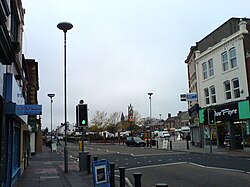Heuthenberg: Difference between revisions
No edit summary |
No edit summary |
||
| Line 16: | Line 16: | ||
| subdivision_name1 = [[Haadland]] | | subdivision_name1 = [[Haadland]] | ||
| subdivision_type2 = Fief | | subdivision_type2 = Fief | ||
| subdivision_name2 = | | subdivision_name2 = Wiljâm-Hylager | ||
| governing_body = Heuthenberg City Council | | governing_body = Heuthenberg City Council | ||
| leader_party = {{wpl|independent politician|Independent}} | | leader_party = {{wpl|independent politician|Independent}} | ||
Revision as of 19:10, 16 February 2020
This article is incomplete because it is pending further input from participants, or it is a work-in-progress by one author. Please comment on this article's talk page to share your input, comments and questions. Note: To contribute to this article, you may need to seek help from the author(s) of this page. |
Heuthenberg | |
|---|---|
| City of Heuthenberg Sted âb Heþenburije (Azmaran) Staad van Heuthenberg (IJssentaal) | |
 | |
| Etymology: Unknown | |
| Country | |
| Province | Haadland |
| Fief | Wiljâm-Hylager |
| Government | |
| • Body | Heuthenberg City Council |
| • Mayor | Ana Stefansdochter van Heuthenberg (Independent) |
| Area | |
| • Total | 45 km2 (17 sq mi) |
| Population | |
| • Total | 40,191 |
| • Density | 890/km2 (2,300/sq mi) |
| Demonym | Heuthenbergerin |
| Town code | 7-HG |
Heuthenberg (/'hɜːθənbɜːrg/; Azmaran: Heþenburije; IJssentaal: Heuthenberg) is a port city and traditional seaside resort located on the west coast of Haadland, Azmara. Located on St. Wiljâm's Peninsula, the city is the westernmost settlement in Azmara, 1km along the coast from St. Wiljâm's Point, the westernmost point in Azmara.
The first records of the town come from the 13th century, denoting a fishing village with a small port under the name of Höthenburge in the modern location of the settlement. However, the town only came into prominence in the late 16th century as a trading port was established in the town, leading to a significant influx of economic migrants to the town in order to work in its docks, causing its population to swell.
The town benefited heavily during the Confederation era of Azmara as it became one of the nation's main ports, taking advantage with the increasing trade with the Asterias and Coius. The town became one of the most prosperous in Azmara as a result, and as a result saw heavy over-representation in the Confederation's government and was declared a city in 1759.
However, at the end of the 18th century trade with Asteria and Coius started to decline and the town saw its prosperity decline. The town also suffered as a result of the increasing centralisation during the 19th century, and the town became the site of multiple revolts from radical liberals in the Second Revolution. However, the new republican government engaged in further centralisation and, under attempts to create a cohesive Azmaran culture, suppressed the IJssentaal language and culture of the city and the greater Haadland coast. In 1891, the city saw a revolt aiming to achieve an independent Haadlandic state, which albeit unsuccessful in its aims led to a temporary softening of the Azmaranisation policies.
The policies would be reinforced under the National Coalition government, which led to further riots and mass support for the 1932 General Strike among the city's inhabitants. After the conclusion of the Great War, the city would market itself as a seaside resort for residents of Aalmsted and other cities in the country, and for much of the rest of the 20th century the town would cater towards this as its primary source of income, albeit seeing a slight decline in this industry as international tourism became more prevalent.
The city had a population of 40,191 in the 2013 census, of which 60% describe themselves as fluent in the native IJssentaal language, making it the only district where a majority of the population speak the language.